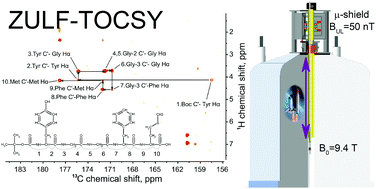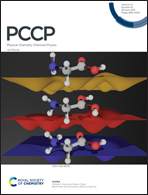Sequential assignment of NMR spectra of peptides at natural isotopic abundance with zero- and ultra-low-field total correlation spectroscopy (ZULF-TOCSY)†
Abstract
A novel method dubbed ZULF-TOCSY results from the combination of Zero and Ultra-Low Field (ZULF) with high-field, high-resolution NMR, leading to a generalization of the concept of total correlation spectroscopy (TOCSY). ZULF-TOCSY is a new building block for NMR methods, which has the unique property that the polarization is evenly distributed among all NMR-active nuclei such as 1H, 13C, 15N, 31P, etc., provided that they belong to the same coupling network, and provided that their relaxation is not too fast at low fields, as may occur in macromolecules. Here, we show that ZULF-TOCSY correlations can be observed for peptides at natural isotopic abundance, such as the protected hexapeptide Boc-Met-enkephalin. The analysis of ZULF-TOCSY spectra readily allows one to make sequential assignments, thus offering an alternative to established heteronuclear 2D experiments like HMBC. For Boc-Met-enkephalin, we show that ZULF-TOCSY allows one to observe all expected cross-peaks between carbonyl carbons and α-CH protons, while the popular HMBC method provides insufficient information.

- This article is part of the themed collection: 2021 PCCP HOT Articles


 Please wait while we load your content...
Please wait while we load your content...